Natural-History-Conservation.com
Conserving and recording a large Ichthyosaurus forelimb about to be described and published Nigel Larkin March 2015
This complete Ichthyosaurus forelimb from the Yorkshire coast is particularly large and interesting and was the focus of a paper
written for a peer-reviewed scientific journal (see bottom of page). However, the fossil was mounted in plaster in a wooden frame many decades ago and the specimen, the plaster surround it was embedded in and the wooden frame containing it had all split and cracked over the years and it was in danger of simply falling apart (see images below). The fossil itself was covered in an old black varnish, was dusty and was suffering from some pyrite decay.
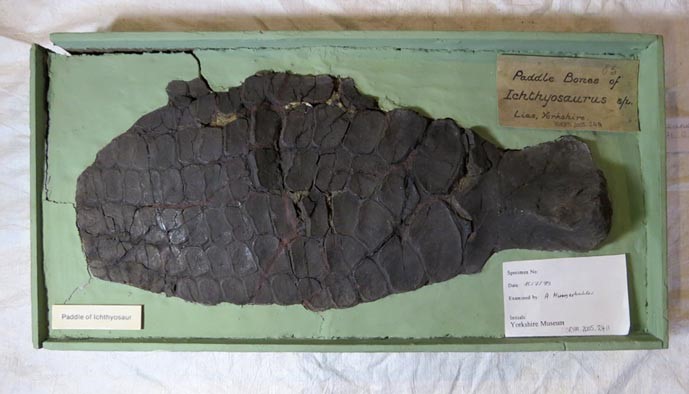


Above left and middle: the specimen before conservation. Above right: between the phalanges in several places there was matrix that had undergone pyrite decay in the past, with the by-products still in place (the yellowy-white areas between the bones).
The treatment required was to remove all the plaster and take apart the wooden frame, clean the specimen, remove old gap fills,
undertake repairs and consolidation and to securely hold all the bones together from behind with resin.
Whilst doing this it needed to be assessed for pyrite oxidation (also known as pyrite decay)
as this may have caused the splitting. Also, the underside of the specimen had to be recorded before being set in plaster or resin again.
Cleaning The specimen was cleaned with a pneumatic airabrasve unit utilising sodium bicarbonate. This removed all the old varnish and some of the by-products of pyrite decay. As much as possible of the matrix between the bones was removed as it became clear after all the cleaning work that the matrix was prone to suffering from pyrite decay: the by-products of pyrite oxidation were clearly evident on the top surfaces of this matrix (see below).
The specimen was then given a couple of coats of consolidant to stabilise it as it was very cracked and a bit friable. Some of the worst breaks had conservation adhesive applied to them. Where it was required, a suitable gap filler was applied (Paraloid B72 mixed with glass beads 44microns diameter: see Larkin and Makridou 1999). All of these products (the consolidant, adhesive and gap filler) are reversible and to a large extent removable with the application of acetone. The products were applied to make the specimen permanently more secure as it was friable and cracked, but also because it specifically required some protection during the next phases of the conservation process: applying silicone wacker rubber to hold all the bones securely in place before the specimen was turned over so that the plaster backing could be removed and replaced with something more appropriate.
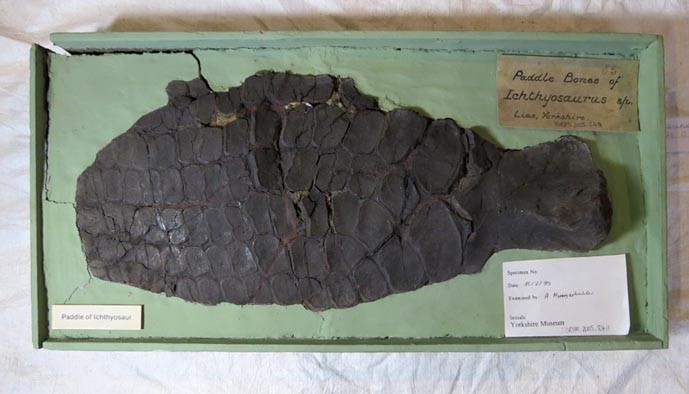

Above left: the specimen before work commenced. Above right: the specimen after cleaning with the
airabrasive, with some old white gap filler visible.
Turning over to improve the backing Gaps in the specimen (between bones and within bones) were filled temporarily with water
soluble putty to protect the fragile bones as the silicone wacker rubber would otherwise infiltrate the cracks in the specimen,
leading to the specimen being torn apart when the rubber was removed later on. The Silicone wacker rubber used is a good quality
museum grade low-oil rubber and was deployed to keep all of the bones securely in place whilst the specimen was turned over and worked
on from behind. Once the rubber had set (it took several layers of increasing viscosity, using a thixotropic additive) a rigid backing
was made from several layers of acrylic resin and glass fibre. As a by-product of this process, a high-quality rubber
mould was made of the top surface of the specimen which may be of use at some point for making replicas. Also,
if the specimen undergoes catastrophic pyrite decay in the future, the mould can be used to make a cast of what
the specimen was like originally.
Once the temporary jacket had been made for the upper surface, the specimen was carefully turned over and the broken wooden frame removed.
It was immediately obvious that the major cracks running through the whole plaster surround and through the specimen were
at least partly the result of pieces of fossil wood in the rear of the specimen undergoing major pyrite decay and subsequent expansion.
Also in the plaster at the rear/underside of the specimen there were stones and a piece of modern timber, all presumably used to bulk-out
the filler and save on plaster. As the fossil wood had degraded through pyrite decay – possibly due to the moisture from the plaster of paris -
this had expanded enough that it caused the whole specimen to crack.
The plaster was slowly removed with pneumatic preparation pens to reveal the underside of the forelimb. There was no extra matrix
on this side, just the bare bones. These were cleaned of all plaster with the airabrasive using sodium bicarbonate powder.
The underside was photographed and a mould was made of the underside of the humerus, radius and ulna and copies cast
for research purposes in case
these were to be used as diagnostic features at some point.
Once all had been recorded, the specimen was consolidated with Paraloid B72 at about 10%. Once this had set, the bones were coated with a couple of layers of Paraloid B72 adhesive to act as a barrier layer between the bones and the plaster of paris that was to be applied once the adhesive had set. A firm, rigid, backing was needed for the whole limb to be permanently stored on. A resin like Jesmonite would be more robust, but in the future would be more difficult to remove than plaster. Therefore plaster of paris was applied first, and then Jesmonite acrylic resin (which bonds quite well to plaster) and fibre glass. The barrier layer of adhesive will protect the bones and the matrix between them from moisture from the plaster, as well as simply physically protecting the surfaces of the bones.
Once the rigid plaster and Jesmonite backing was made for the whole of the forelimb, the specimen was turned the right way round, the Jesmonite and rubber ‘mould’ was carefully removed, the water soluble putty in the cracks and gaps was painstakingly removed with scalpels, needles, tweezers, brushes and compressed air, and the specimen cleaned again before receiving a final dilute application of Paraloid consolidant.
Below: the specimen after being turned over and the wooden frame removed.
The black area in the middle is the decayed piece of fossil wood that was not attached to the specimen and from which the cracks originate.

Below: After some plaster is removed, more assorted items are found within the plaster: stones and wood (on the far right is the underside of the humerus).

Below: after more plaster is removed the forelimb emerges, with no additional matrix associated.
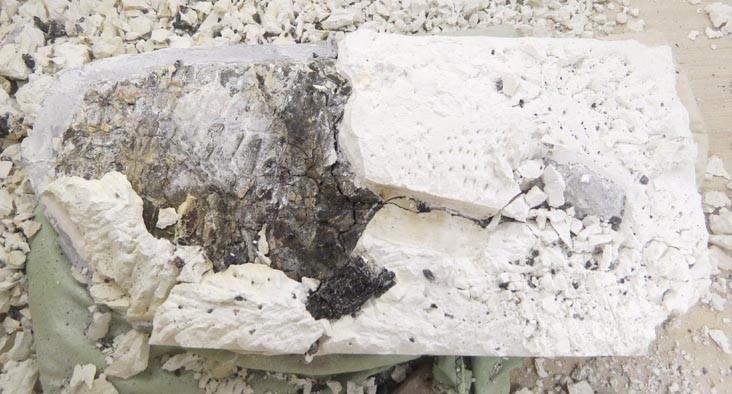
Below: The underside of the forelimb after the plaster is largely removed.

Below: the underside of the forelimb after cleaning with the airabrasive
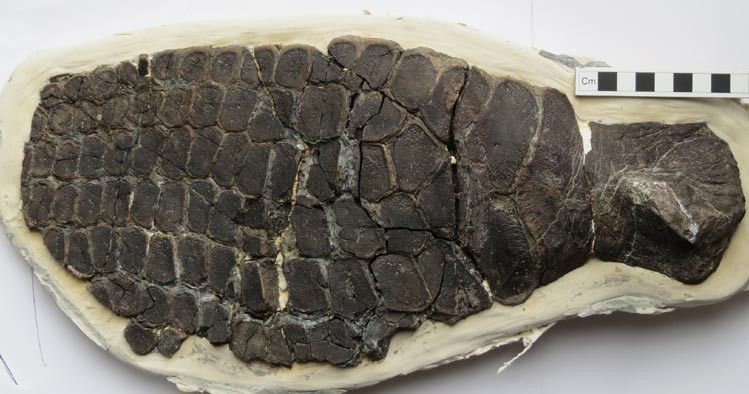
Below: after making the secure permanent backing and turning the specimen the right way round,
this is what the specimen looks like from directly above.
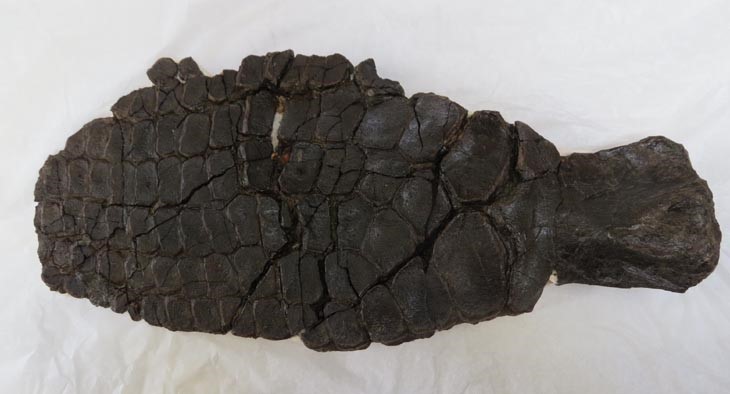
Below: The specimen from the side.
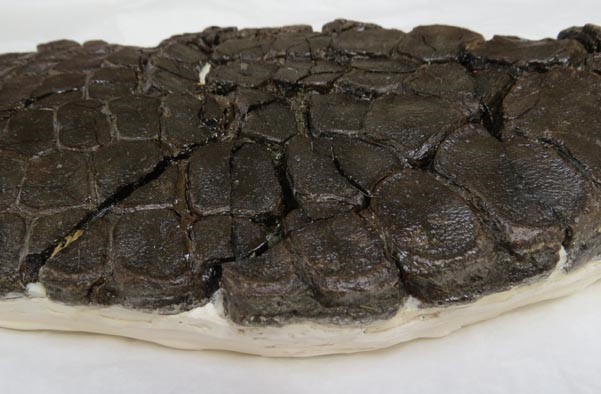
A LARGE FOREFIN OF ICHTHYOSAURUS FROM THE U.K., AND ESTIMATES
OF THE SIZE RANGE OF THE GENUS
In Paludicola 10(2):119-135 May 2015
By Judy A. Massare, Dean R. Lomax, and Amanda Klein.
ABSTRACT
A large partial forefin (YORYM 2005.2411) from the Lower Jurassic of Yorkshire is assigned to Ichthyosaurus on the basis of the humerus shape, two digits originating from the intermedium, and an anterior digital bifurcation. The humerus is 11.7 cm long and the forefin is 38.5 cm long, but incomplete, probably missing more than 1/3 of its length. Regression analyses suggest that the individual had a jaw length of 56 cm and a total length to the tail bend of almost 3 m. This individual represents the largest Ichthyosaurus reported from the U.K. Although interest in the reptiles of the Yorkshire coast dates back to the early 1800s, specimens of Ichthyosaurus from the area are rare.
For more details about what we can do for you, or for a quote, please
contact:
enquiries@natural-history-conservation.com
We
are members of the United Kingdom Institute for Conservation of Historic and
Artistic Works
Back to
the home page











